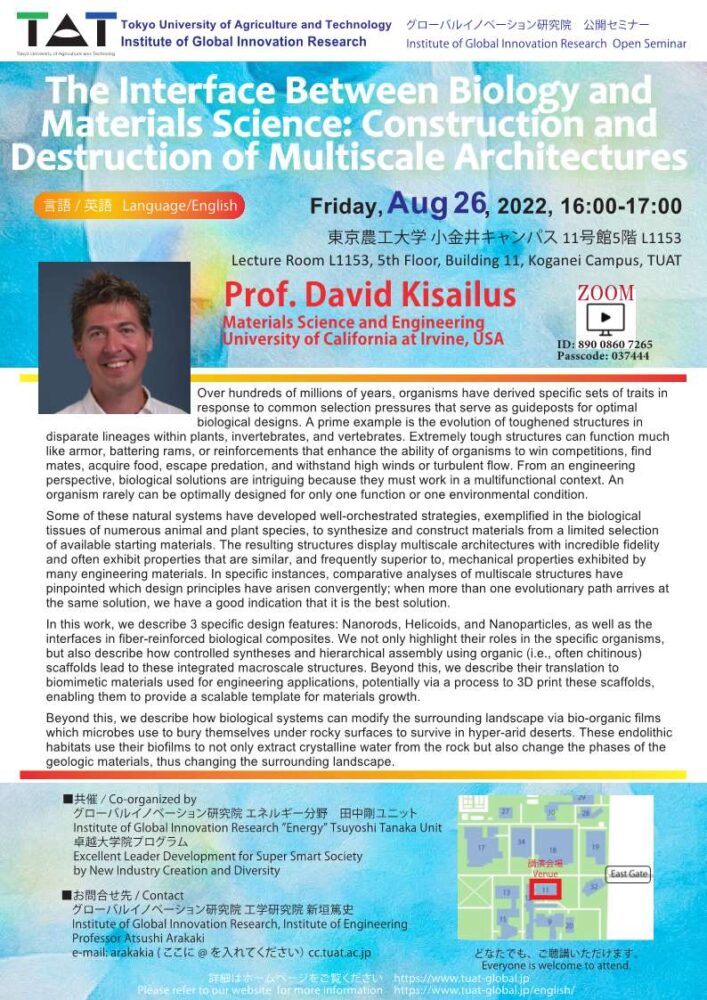Event
【GIR Open Seminar】Dr. David Kisailus / University of California, Irvine

| Date | 2022.8.26 (16:00 - 17:00) |
|---|---|
| Venue | |
| Speaker | Dr. David Kisailus |
| Affiliation | University of California, Irvine (U.S.A.) |
| Title | ◆Title: The Interface Between Biology and Materials Science: Construction and Destruction of Multiscale Architectures <Abstract> Over hundreds of millions of years, organisms have derived specific sets of traits in response to common selection pressures that serve as guideposts for optimal biological designs. A prime example is the evolution of toughened structures in disparate lineages within plants, invertebrates, and vertebrates. Extremely tough structures can function much like armor, battering rams, or reinforcements that enhance the ability of organisms to win competitions, find mates, acquire food, escape predation, and withstand high winds or turbulent flow. From an engineering perspective, biological solutions are intriguing because they must work in a multifunctional context. An organism rarely can be optimally designed for only one function or one environmental condition. Some of these natural systems have developed well-orchestrated strategies, exemplified in the biological tissues of numerous animal and plant species, to synthesize and construct materials from a limited selection of available starting materials. The resulting structures display multiscale architectures with incredible fidelity and often exhibit properties that are similar, and frequently superior to, mechanical properties exhibited by many engineering materials. In specific instances, comparative analyses of multiscale structures have pinpointed which design principles have arisen convergently; when more than one evolutionary path arrives at the same solution, we have a good indication that it is the best solution. In this work, we describe 3 specific design features: Nanorods, Helicoids, and Nanoparticles, as well as the interfaces in fiber-reinforced biological composites. We not only highlight their roles in the specific organisms, but also describe how controlled syntheses and hierarchical assembly using organic (i.e., often chitinous) scaffolds lead to these integrated macroscale structures. Beyond this, we describe their translation to biomimetic materials used for engineering applications, potentially via a process to 3D print these scaffolds, enabling them to provide a scalable template for materials growth. Beyond this, we describe how biological systems can modify the surrounding landscape via bio-organic films which microbes use to bury themselves under rocky surfaces to survive in hyper-arid deserts. These endolithic habitats use their biofilms to not only extract crystalline water from the rock but also change the phases of the geologic materials, thus changing the surrounding landscape. [1]. “Multiscale toughening mechanisms in biological materials and bioinspired designs,” W. Huang, D. Restrepo, J.Y. Jung, F.Y. Su, Z. Liu, R.O. Ritchie, J. McKittrick, P. Zavattieri, D. Kisailus, Advanced Materials, 31 (43) (2019) 1901561. [2]. “Mechanism of water extraction from gypsum rock by desert colonizing microorganisms,” W.Huang, E. Ertekin, T. Wang, L. Cruz, M. Daily, J. DiRuggiero, D. Kisailus, PNAS, 117 (20) (2020) 10681-10687. [3]. “Radular Stylus of Cryptochiton stelleri: A Multifunctional Lightweight and Flexible Fiber-Reinforced Composite,” A. Pohl, S.A. Herrera, D. Restrepo, R. Negishi, J.Y. Jung, C. Salinas, R. Wuhrer, T. Yoshino, J. McKittrick, A. Arakaki, M. Nemoto, P. Zavattieri, D. Kisailus, J. Mechanical Behavior of Biomedical Materials, 111 (2020) 103991. [4]. “A natural impact resistant bi-continuous composite nanoparticle coating,” W.Huang, M. Shishehbor, N. Guarín-Zapata, N.D. Kirchhofer, J. Li, L. Cruz, T. Wang, S. Bhowmick, D. Stauffer, P. Manimunda, K.N. Bozhilov, R. Caldwell, P. Zavattieri, D. Kisailus, Nature Materials, 9 (11) (2020) 1236-1243. [5]. “Toughening Mechanisms of the Elytra of the Diabolical Ironclad Beetle,” J. Rivera, M.S. Hosseini, D. Restrepo, S. Murata, D.Y. Parkinson, H.S. Barnard, A. Arakaki, P. Zavattieri, D. Kisailus, Nature, 586 (2020) 543-548. [6]. “Structural Design Variations in Beetle Elytra”, J. Rivera, S. Murata, M. Hosseini, A. Pickle, A. Trikanad, W. Yang, N. Matsumoto, D. Parkinson, H. Barnard, P. Zavattieri, A. Arakaki, D. Kisailus, Adv. Funct. Materials, (2021) 2106468. [7]. “Comparative proteomics reveals expression variations in major cuticular proteins of beetle elytra" S. Murata, J. Rivera, M. Noh, N. Hiyoshi, W. Yang, D. Parkinson, H. Barnard, Y. Arakane, D. Kisailus, A. Arakaki, Acta Biomat., 140, (2022) 467-480. [8]. “Mesocrystalline Ordering and Phase Transformation of Iron Oxide Biominerals in the Ultrahard Teeth of Cryptochiton stelleri,” T. Wang, W. Huang, C. Pham, S. Murata, S. Herrera, N. Kirchhofer, B. Arkook, D. Stekovic, M. Itkis, N. Goldman, L. Zepeda-Ruiz, M. Zhernenkov, M. Nemoto, A. Arakaki, D. Kisailus, Small Structures, (2022) 2100202. [9]. “Nano-Architected Tough Biological Composites from Assembled Chitinous Scaffolds”, W. Huang, D. Montroni, T. Wang, S. Murata, A. Arakaki, M. Nemoto, D. Kisailus, Accounts of Chemical Research, 55 (10) (2022) 1360-1371. [10]. “Fibrous Anisotropy and Mineral Gradients within the Radula Stylus of Chiton: Controlled Stiffness and Damage Tolerance in a Flexible Biological Composite”, J.E. Lee, J. Connolloy, W. Yang, G. Freychet, T. Wang, S. Herrera, S. Murata, P.S. Dasika, D. Montroni, C. Zhu, M. Zhernenkov, R. Wuhrer, L. Sheppard, M. Nemoto, A. Arakaki, P. Zavattieri, D. Kisailus, J. Comp. Materials, accepted (2022). [11]. “Direct ink write printing of chitin-based gel fibers with customizable fibril alignment, porosity, and mechanical properties for biomedical applications”, D. Montroni, T. Kobayashi, T. Hao, D. Lublin, T. Yoshino, D. Kisailus, J. Funct. Biomaterials, 13 (2) (2022) 83. |
| Language | English |
| Intended for | Registration is required for on-site seminar |
| Co-Organized by | Institute of Global Innovation Research, “Energy" Tsuyoshi Tanaka Unit Excellent Leader Development for Super Smart Society by New Industry Creation and Diversity |
| Contact | Institute of Global Innovation Research, Institute of Engineering Prof. Atsushi Arakaki e-mail: arakakia(at)cc.tuat.ac.jp |
| Remarks | Please contact Prof. Arakaki for the registration of on-site seminar.
※On-line Seminar via Zoom is also available. (This seminar will be distributed by Google Class Room later on) |
このページの上部へ